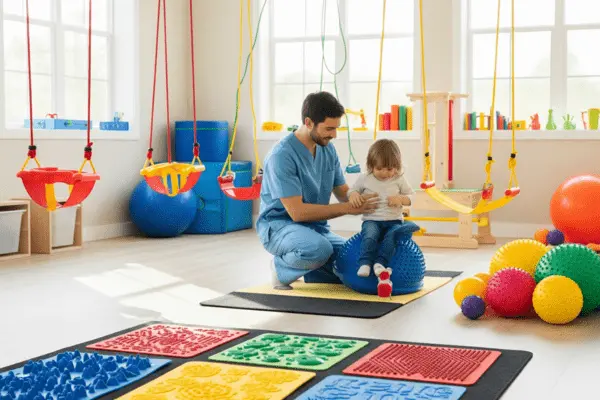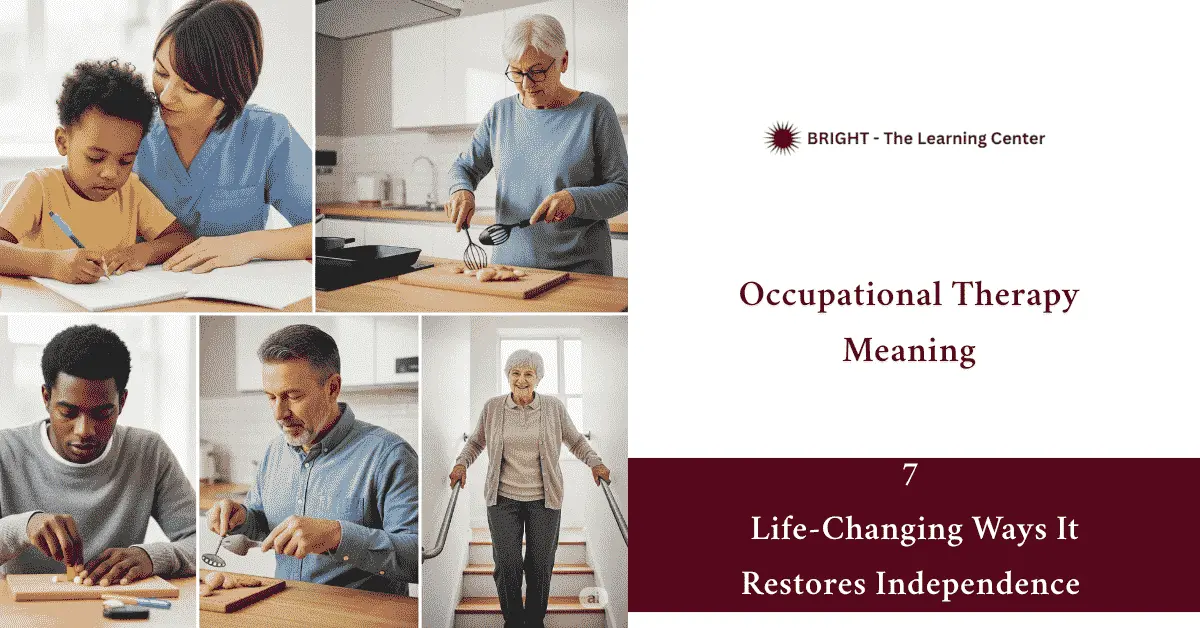Occupational therapy meaning goes far beyond clinical definitions—it’s about restoring independence in daily life. Occupational therapy empowers individuals—from toddlers with motor challenges to adults regaining strength post-injury—to live with confidence. This guide explains who needs it, what to expect, and how it makes a difference.
Table of Contents
Occupational Therapy Meaning & Everyday Impact
Occupational therapy meaning lies in helping individuals regain the skills needed for everyday living. Whether managing a chronic condition or recovering from a stroke, it delivers structured support to restore function.
But what qualifies as “everyday”? Cooking, writing, brushing teeth, getting dressed—simple tasks whose absence disrupts everything. That’s where occupational therapy steps in: quietly, effectively, with purpose.
At its core, occupational therapy meaning revolves around enabling participation in meaningful tasks. These may include:
- Motor rehabilitation after injury
- Memory and focus training
- Sensory therapy for children
- Modifying home or work environments
- Building routines for mental wellness
Occupational therapists remove barriers—physical, cognitive, or emotional—so people can engage with life again. Imagine regaining the confidence to cook after a hand injury, or a child zipping up their coat for the first time. These aren’t just tasks. They’re milestones.

Who Needs It? Kids to Seniors
Occupational therapy meaning becomes clearer when viewed across the human lifespan. From toddlers to older adults, it supports functional growth and recovery in deeply personal ways.
For Children:
- Fine motor delays
- Poor handwriting
- Sensory challenges
- Difficulty with feeding, dressing, or focus
A child struggling to grip a pencil or stay seated in class gains more than skills—they gain confidence and calm.
For Adults:
- Rehabilitation post-surgery or accident
- Managing arthritis, MS, or chronic fatigue
- Regaining roles after mental health disruptions
For Seniors:
- Fall prevention and home safety
- Dementia support and memory training
- Maintaining independence in daily care
Occupational therapy protects dignity at every age. What seems like a small task—buttoning a shirt, making tea—is often a lifeline to identity and freedom.
Inside a Session: Tools & Techniques
Occupational therapy meaning comes alive in practice. What happens during a session? Simple tools. Intentional strategies. Constant progress.
Sessions begin with observation or jump into action. The tools used may be basic, but their impact isn’t.
Common tools and methods:
- Therapy putty and hand grips
- Adaptive utensils for independent eating
- Weighted vests for sensory balance
- Visual schedules for attention training
- Fine motor games like puzzles or threading beads
Therapists don’t just supervise—they adapt and coach. They may elevate a chair, modify a toothbrush, or turn sorting socks into motor rehab. Each moment in the session is deliberate.
This is hands-on therapy—not passive treatment.
Boosting Function: Mind & Body
Occupational therapy meaning spans both physical recovery and cognitive support. Daily life demands coordination between the two.
Physically:
- Strengthening hand control
- Improving coordination and range of motion
- Training specific movements like dressing or grooming
Picture a stroke survivor writing again with their non-dominant hand. That’s not rehabilitation—it’s resilience in motion.
Cognitively:
- Enhancing memory and attention
- Establishing sequences for routines
- Using reminders, prompts, or structured plans
Recovery isn’t just visible—it’s mental. The ability to follow a recipe or recall appointments restores agency.
This therapy isn’t about perfection. It’s about participation, however small, in everyday tasks that carry meaning.
Sensory & Emotional Benefits
Occupational therapy meaning stretches into emotional stability and sensory regulation. For those overwhelmed by sights, sounds, or unpredictability, it offers tools—not silence or restraint.
Sensory Interventions:
- Deep pressure for calming
- Brushing or tactile input for sensory tolerance
- Movement-based tools (swings, bouncing)
These help the nervous system adapt, not overreact. The goal is not to erase sensation, but to manage it.
Emotional Strategies:
- Structuring activities to reduce anxiety
- Visual timers for smoother transitions
- Simplifying tasks to prevent shutdowns
Meltdowns turn into manageable moments. Avoidance gives way to engagement. Occupational therapy doesn’t just change routines—it changes emotional responses to life.
Getting Started: Steps to Begin OT
Occupational therapy meaning becomes personal once someone takes the first step. Starting is simpler than it seems.
Step 1: Spot the Signs
Struggling with basic tasks, attention, or coordination? Feeling overwhelmed by daily routines? These are early signals.
Step 2: Referral or Direct Contact
Depending on location, you can seek therapy with or without a referral. Pediatricians, physicians, teachers, and even mental health professionals can help you connect.
Step 3: Assessment
The initial session includes evaluation—physical movement, attention span, emotional triggers. No needles, no tests. Just observation, conversation, and goal-setting.
Step 4: Build a Plan
Therapy goals might include preparing lunch safely or maintaining a steady morning routine. These are not vague intentions—they’re tracked, adjusted, and celebrated.
Step 5: Attend Regular Sessions
Sessions may be once a week or more. Frequency depends on progress and goals. Homework and caregiver guidance often extend the impact beyond the clinic.
Occupational therapy is a process—but a hopeful one. It doesn’t ask for perfection. It asks for effort, and it rewards it with results.
Find a Licensed Therapist Near You
Occupational therapy meaning only becomes real through professional guidance. The right therapist listens, adapts, and supports.
Where to look:
- Medical hospitals and outpatient clinics
- School-based therapy departments
- National and local OT directories
- Recommendations from doctors or educators
Use this quick checklist:
| Criteria | Why It Matters |
| Licensed OT | Confirms professional training |
| Specialty (peds, geriatrics, mental health) | Matches patient need |
| Accessibility | Location, flexible timing, language |
| Communication style | Comfort level and clarity during visits |
The right therapist won't just walk you through exercises. They'll celebrate progress, reframe setbacks, and help translate therapy into real-world success.
Frequently Asked Questions
What is the meaning of occupational therapy?
Occupational therapy means helping individuals regain or improve the ability to perform everyday tasks after injury, illness, or developmental delays.
What does an occupational therapist do?
An occupational therapist evaluates functional challenges and uses practical tools and strategies to improve a person’s daily life, independence, and well-being.
Who benefits from occupational therapy?
Children with developmental delays, adults recovering from injury or illness, and seniors with memory or mobility issues all benefit from occupational therapy.
What happens in an occupational therapy session?
Sessions may involve motor training, sensory activities, cognitive tasks, or adaptive tools, depending on the individual’s goals and challenges.
How do I start occupational therapy?
Start by noticing functional struggles, seeking a referral or contacting a licensed therapist, undergoing assessment, and following a personalized therapy plan.

